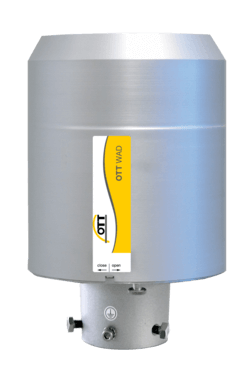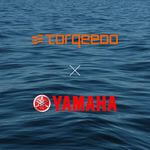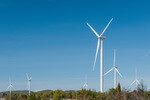OTT Hydromet launches self-draining rain sensor
These include various measuring systems for the detection of liquid and solid precipitation. The sensors can be used in both cold and warm climate zones. Recently, the precipitation sensor family has been joined by two new models: The maintenance-free, radar-based Lufft WS100 in 2017 and the OTT WAD in 2018. WAD stands for "weighing and draining" and describes a unique measuring principle that combines the advantages of weighing and collecting rain gauges.
The high measuring accuracy meets the requirements of WMO guideline No. 8. It specifies that rain sensors have a maximum inaccuracy of ± 3%. In addition, it outputs precipitation intensities and total values in real time in the impressive measuring range of 0.001 to 720 mm / h.
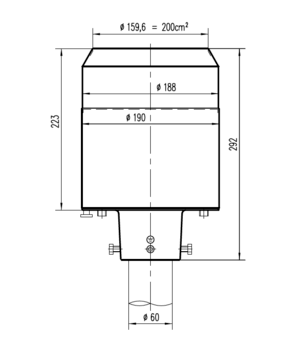 The new, self-draining tilt-balance system represents an alternative to the OTT Pluvio2 sensor and is especially suitable for use in subtropical and tropical climates. These are characterized by heavy rain showers with up to 10,000 mm per year as well as extreme weather events in the form of hurricanes and typhoons. He is able to output the measured values "event" (rain yes / no), rainfall, rain intensity and the total amount.
The new, self-draining tilt-balance system represents an alternative to the OTT Pluvio2 sensor and is especially suitable for use in subtropical and tropical climates. These are characterized by heavy rain showers with up to 10,000 mm per year as well as extreme weather events in the form of hurricanes and typhoons. He is able to output the measured values "event" (rain yes / no), rainfall, rain intensity and the total amount.
The OTT WAD combines a tilting and a weighing system. This has the advantage that the sensor takes into account weight increases and does not distort data by evaporation or unintentional emptying, as can be the case with storage containers.
The priciple explained in more detail
The high-precision, monolithic, self-draining collection device has two chambers that alternately fill with precipitate. When a certain volume is reached, the monolith tilts and empties. Each droplet is monitored at a resolution of 0.001 mm / m2, accurate to ± 10 mg due to the high-precision weighing system.
Calibration
Calibration is performed using a precision reference weight in combination with monitoring, configuration, and maintenance software. The sensor is connected to the computer via a standard USB port. The calibration and adjustment are possible according to the ISO standard over the entire intensity range from impressive 0 to 720 mm / h.
Interfaces
The OTT WAD precipitation sensor combines maximum functionality with a very compact design. A total of six analog, digital and serial interfaces, such as SDI-12 and RS-485 with different output telegrams, allow easy integration into different systems and networks.
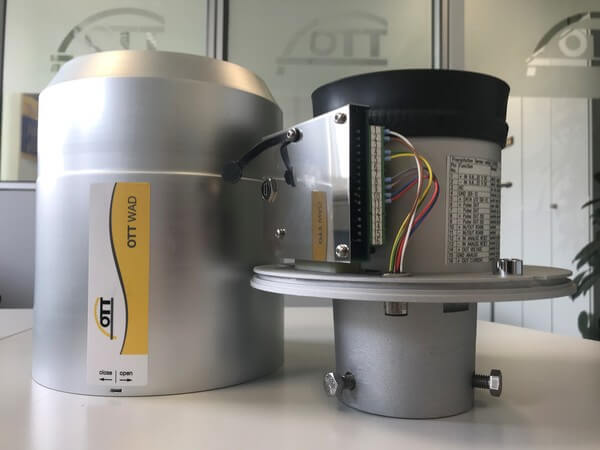
Testing
In field tests, in which meteorological services and institutes compared the OTT WAD directly with collecting weighing sensors or manual testing gauges, no negative measuring effect could be detected by the funnel. It is the successor to conventional tilting bucket systems, which are particularly suited to the comparison of long time series and historical precipitation data and based on the same housing design and two-part tilting bucket system. However, the primary weighing principle of the new WAD ensures far better measurement performance than its predecessors.
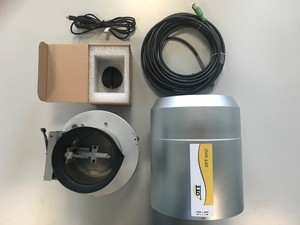 Measurements and weight
Measurements and weight
The small housing dimensions and the low weight of 2.5 kg result in lower logistics and installation costs than other weighing systems or optical precipitation sensors. The OTT WAD is thus approximately 50% cheaper than other precipitation gauges - with comparable or even superior functionality. It is, therefore, suitable for integration into existing measuring fields and in hard-to-reach places and can easily replace tilting scales or manual measuring devices.
OTT WAD − Operation
The liquid precipitate is collected through the funnel with a collection area of 200 cm2 or 314 cm2, respectively. From there it passes via the drop generator into the self- emptying collection container, where the drop is weighed immediately.
However, it is not the absolute weight that is monitored, but the weight gain over the previous measurement. Due to the high sampling rate, the sensor compensates for long-term drift, temperature drift, and evaporation almost automatically.
If one of the measuring chambers is full, the collecting device tilts and empties while the measurement in the second chamber continues. During the tilting process, the OTT WAD compensates for possible deviations by a built-in algorithm as an interpolation of the temporary phase between previous and next real-time measurement.
The typical flip frequency is once per second with a maximum intensity of 720 mm / hand a peak capacity of 0.2 mm. The filter stages following the funnel compensate for wind, shock, vibration and wind effects.
After filtering, the OTT WAD analyzes the weight gain and - in the simplest case - outputs it as a precipitation event. At a correlation of 20 mg or 0.001 mm, the precipitate is calculated with a resolution of 0.001 mm and accumulated since the last data retrieval or as a total amount since system startup.
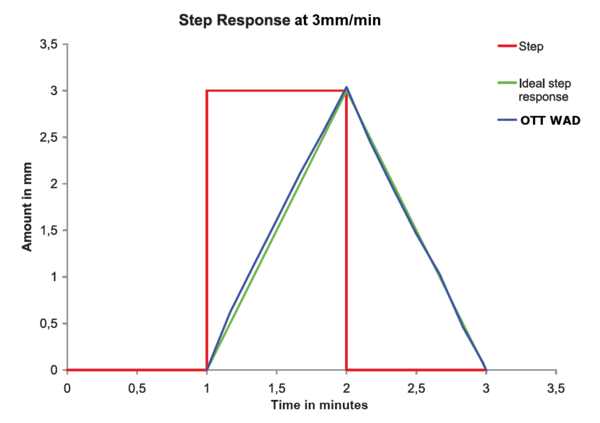
The image above shows the step signal after one minute at an intensity of 3 mm/min (red). It is output via the serial interface of the OTT WAD. The measured amount of precipitation (blue) corresponds to the ideal step signal of a one-minute tilt intensity (green) and shows the fast reactivity compared to other precipitation sensors. The step signal was confirmed by several weather services.
The OTT WAD calculates the precipitation intensity from the volume increase. Then this is available as precipitation intensity during the last measured minute in mm/min and mm/h, as a value since the last measurement or as precipitation intensity during a time t as average, minimum and maximum value.
For intensity measurements, it is recommended to refer to the calculated values instead of calculating the intensity based on counted pulses performed on conventional tilting bucket meters. This is also important to comply with the WMO Intensity parameter policy with a maximum delay of 60 seconds as a step response.
The pulse output is intended only for the quantity measurement since it can be significantly delayed depending on the rain intensity with appropriate bucket capacity and resolution.
The serial interfaces RS-485 and SDI-12 offer the best measurement results as well as the most extensive functionalities. In addition to the measured data, the serial interfaces also provide various operating data and error messages. They help the analysis of the measuring quality.
Rainfall data can still be generated as analog value (0/4 ... 20 mA, 0 ... 2.5 / 5 V) or as pulse value via the Open-Collector.
CHARACTERISTICS AT A GLANCE
- A weighing system consisting of two containers with 4 ml each for the detection of liquid precipitation
- Self-draining by tilting bucket using the gravity principle to avoid manual draining and overflow
- Precise measurement over the entire intensity range from 0 to 720 mm / h due to an integrated microcontroller and correction function
- Real-time data on intensity and cumulative rainfall without filtering or delay
- Equivalent time series comparable to the recorded time series based on tipping-bucket networks with the same characteristics, but without intensity errors
- Calibration is performed using a reference weight according to ISO standard instead of water volume to capture only a small intensity value
- Accuracy check after cleaning and annual calibration via USB interface and OTT WAD Commander (software) by the user in the field or laboratory possible
- Lower price than the OTT Pluvio2 series (designed to monitor solid and liquid precipitation and therefore difficult to use for rain monitoring)
- Funnels with embedded spiral and protective grid to prevent the ingress of leaves and animals into the device
- Source:
- Lufft
- Author:
- Kurt Nemeth
- Link:
- www.lufft.de/...
- Keywords:
- OTT Hydromet, Lufft, sensor, rain sensor, product, meteorology, measurement

